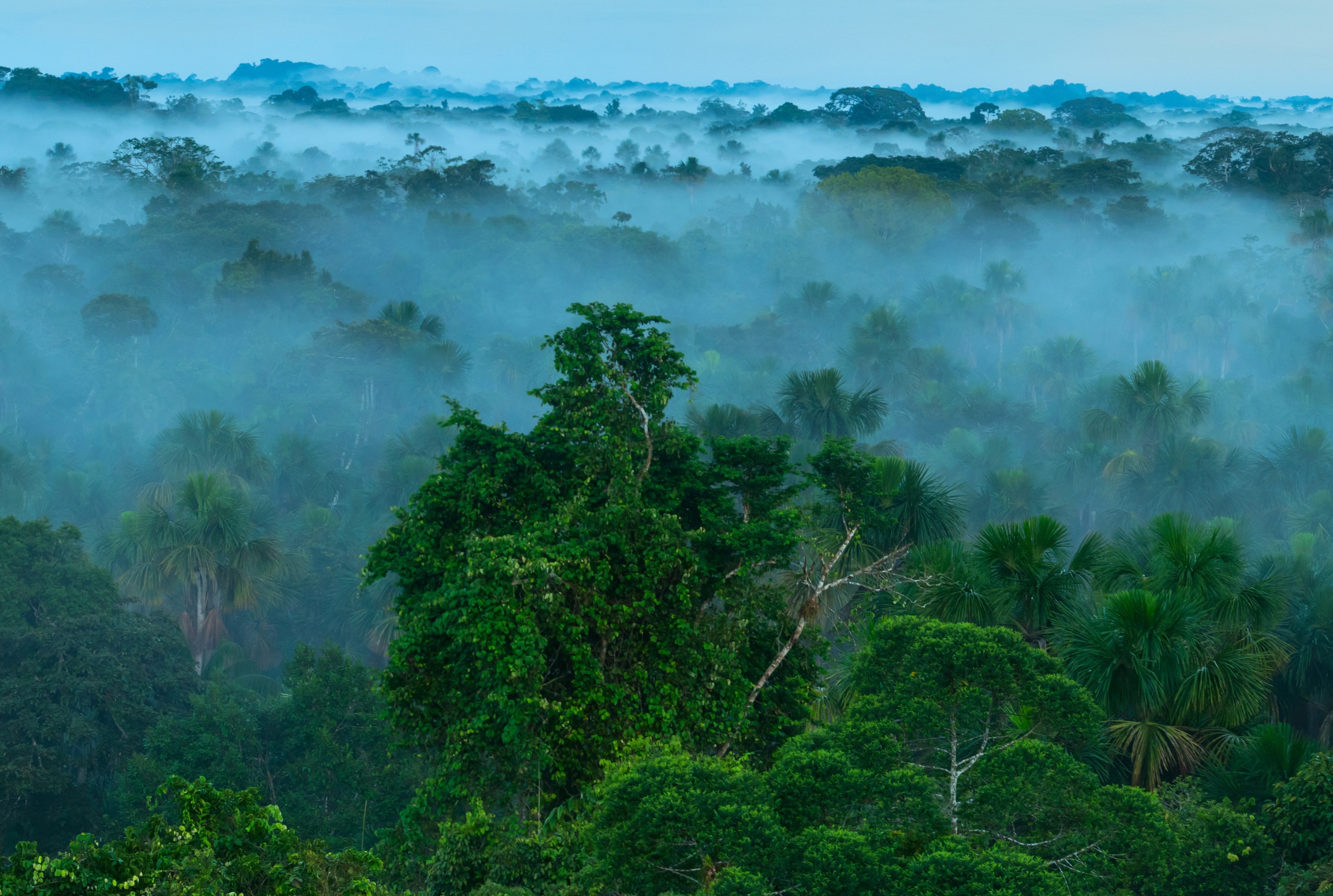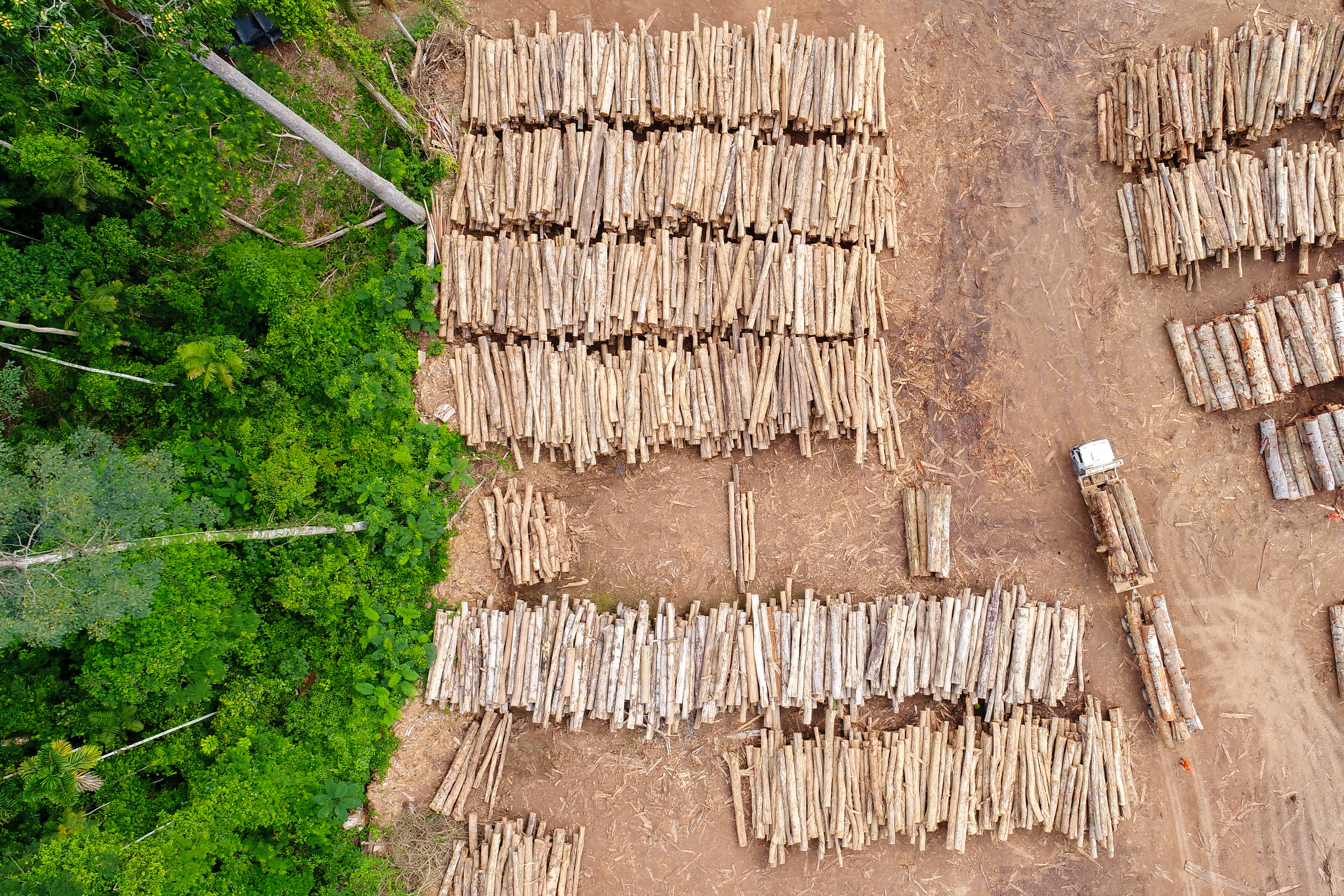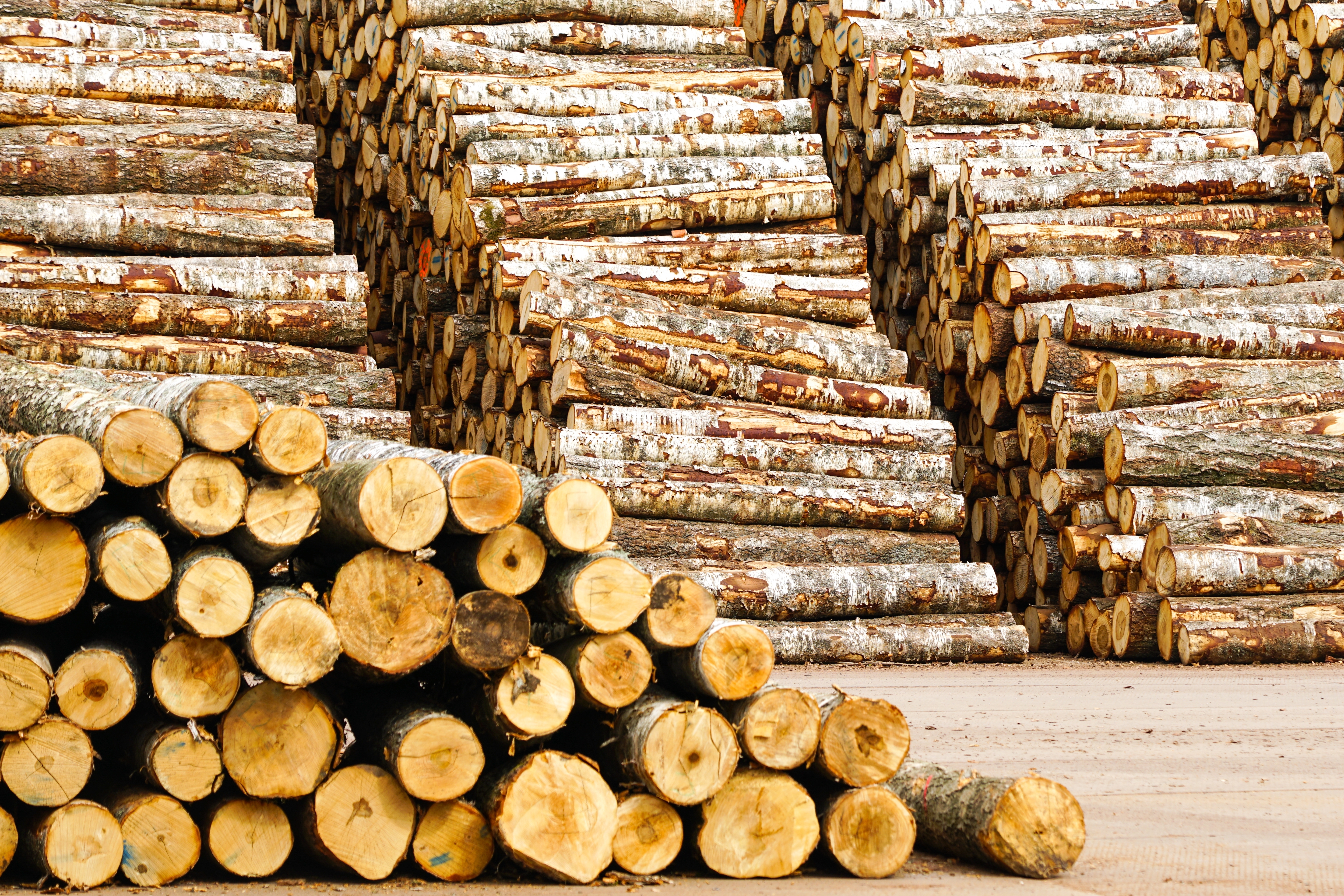When the government of Paraguay enacted a law banning
deforestation in 2004, it marked what might have become one of the most
significant success stories in global forest conservation. The Atlantic forest,
that once stretched unbroken from the river Paraguay to the Brazilian coast,
faced outright destruction at the hands of soy companies and cattle ranchers.
As a result of the zero deforestation law, the rate of forest loss dropped
precipitously; by 65% within two years, and by almost 95% within five. Though
much of the forest had already been destroyed, this rearguard action represented
a rare moment of decisive, state-led leadership in the global effort to stem
deforestation.
Instead, the law played a significant role in what has
become one of the world’s most pressing environmental crises. While affording
legal protection to the tropical forests in eastern Paraguay’s east, the law
did not extend to the altogether different forests in its west, in the land
known as the Gran Chaco. As the rate of deforestation plummeted in the
east, the Chaco experienced a commensurate wave of destruction. The
contrast in fortunes was stark. Before the law was enacted the rate of
deforestation in the Atlantic forest was the second highest in the world; a few
years later, the Chaco was being destroyed faster than anywhere else on earth
(WWF 2006; Hansen et al 2013).
While the deforestation was sanctioned, even encouraged, by
the state and not in violation of the deforestation law, the expansion of
agriculture into the Chaco has been carried out illegally in a range of other
ways. It is founded upon the corrupt allocation of land during Paraguay’s
35-year dictatorship, it is violating the constitutional rights of its
indigenous people and international law, and it is characterized by impunity
and government complicity that allows violations of environmental law to go
unpunished. Today the Gran Chaco is not only ground zero for deforestation; it
is also ground zero for illegal, large-scale agriculture.
The Chaco and the Ayoreo
Paraguay is split down the middle by the river of the same
name. The Rio Paraguay courses past the capital, Asuncion, which lies
at the heart of the central belt that provided Paraguay with almost all of
its agricultural land until the latter half of the 20th century. By the
middle of the century, around half of the country was still covered in forests,
which varied greatly depending on the direction taken from the river. To the
east lay flat grasslands, swamps, and the dense tropical and subtropical
forests that stretched for more than 1,000km to the Atlantic coast. To the
west, the vast plains of the Gran Chaco, that continue north, west and south
for hundreds of kilometers, into Bolivia and Argentina.
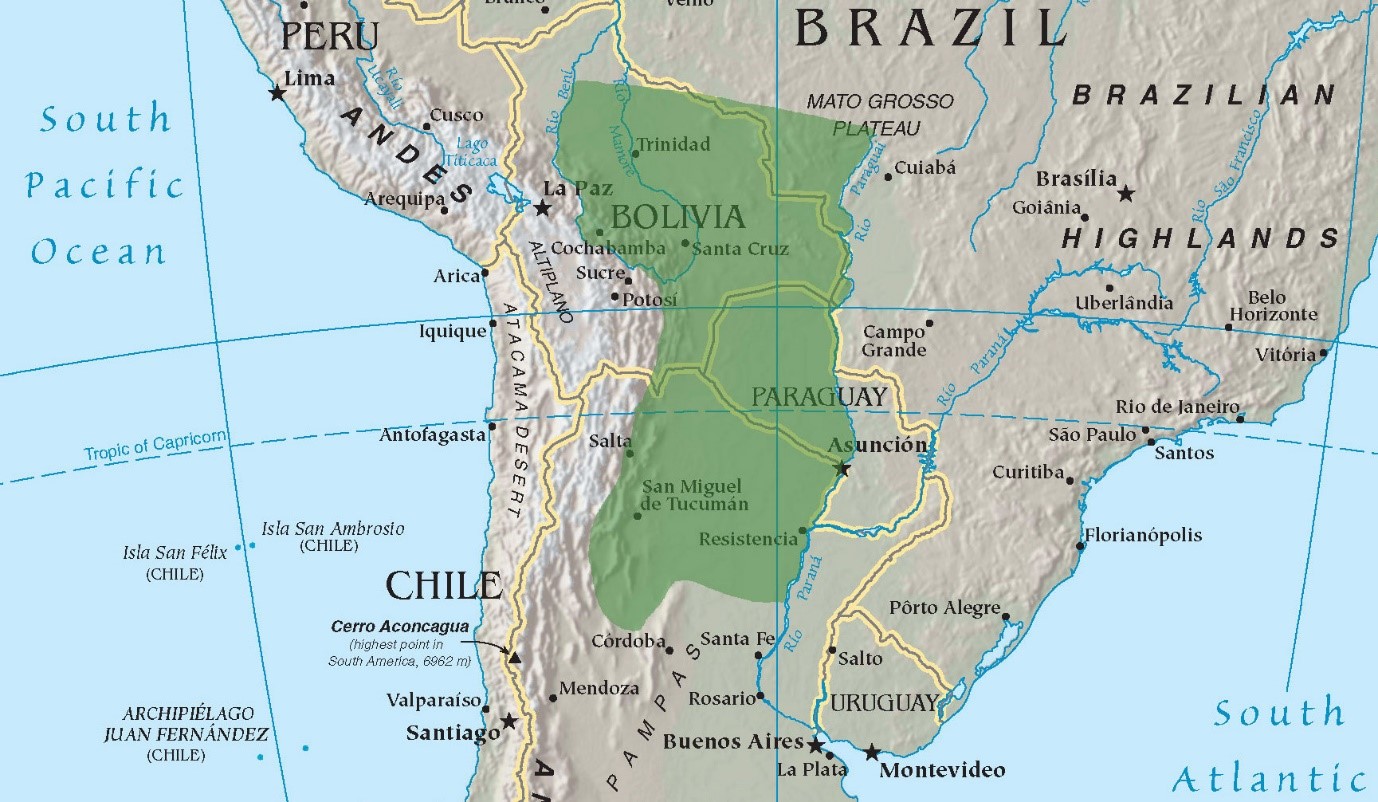
The Paraguayan Chaco extends from the Rio Paraguay into Bolivia and Argentina
The plains have been built up over thousands of years by
fine debris from the Andes mountains, distributed by meandering streams that
traverse the Chaco and flow eventually into the Rio Paraguay. The flat, arid
landscape gave rise to a unique biodiversity that differs starkly from that of
the east; scrub woodlands, forests of thorny, deciduous trees, patches of tall
savanna grass. Lucas Bessire, an American anthropologist who spent several
years in the Chaco recalled “thicket so dense you can’t see more than ten or
fifteen feet, even when you’re crawling through it.” (Bessire 2014) A report of
a geological survey in the 1930s described “peculiar brush forests of mesquite
and many other thorny semidesert plants that are adapted to alternations of
severe droughts and prolonged wet seasons when almost all of the surface of the
Gran Chaco is swampy or actually covered by water.” (US Department of the
Interior 1959)
This forbidding landscape, amounting to the largest expanse
of forest in South America outside the Amazon, offered no obvious resources of
interest to colonial invaders, whose settlements were limited to the fringes of
the Chaco. Most of Paraguay’s indigenous groups were subject to wholesale
slaughter during the Spanish conquest and colonisation. But those whose
territory lay in the Chaco were relatively unscathed until the
19th century. Several thousand people who identified themselves
collectively as the Ayoreo led nomadic lifestyles in the remote wilds of the
Chaco, in what falls within modern Paraguay and Bolivia. The Ayoreo were
loosely organised into more than 50 groups that moved within extensive
territories. With a dynamic social and political structure, individuals left,
joined and formed new groups seamlessly. Until the intervention of outsiders,
the vast territory used by the peripatetic Ayoreo for hunting and gathering
stretched across more than 300 square kilometres of the Chaco (UNAP and
IA 2010).
After independence from Spain was secured in 1811, however,
successive authoritarian regimes “adopted policies aimed at confiscating lands
in the Chaco” (UN Special Rapporteur 2015). These efforts accelerated in the
early 20th century, when the government promoted immigration to the Chaco
from Europe by offering parcels of land in Ayoreo territory (ibid). This led to
the establishment of colonies of Mennonite missionaries in the southern reaches
of their lands. The Mennonites were followed, more aggressively, by Protestant
missionaries who sought to convert the Ayoreo. They were “lured into leaving
their lives in the forest and deported to live in large, permanent settlements
established by missionaries” on the fringes of their Chaco (UNAP and
IA 2010). Throughout the dictatorship that prevailed in Paraguay from 1954
to 1989 indigenous peoples became the victims of “grave and systematic
violations of their rights, including attacks by civilians and the military”
(UN Special Rapporteur 2015), while legal rights to the lands from which they
had been evicted were granted to others.
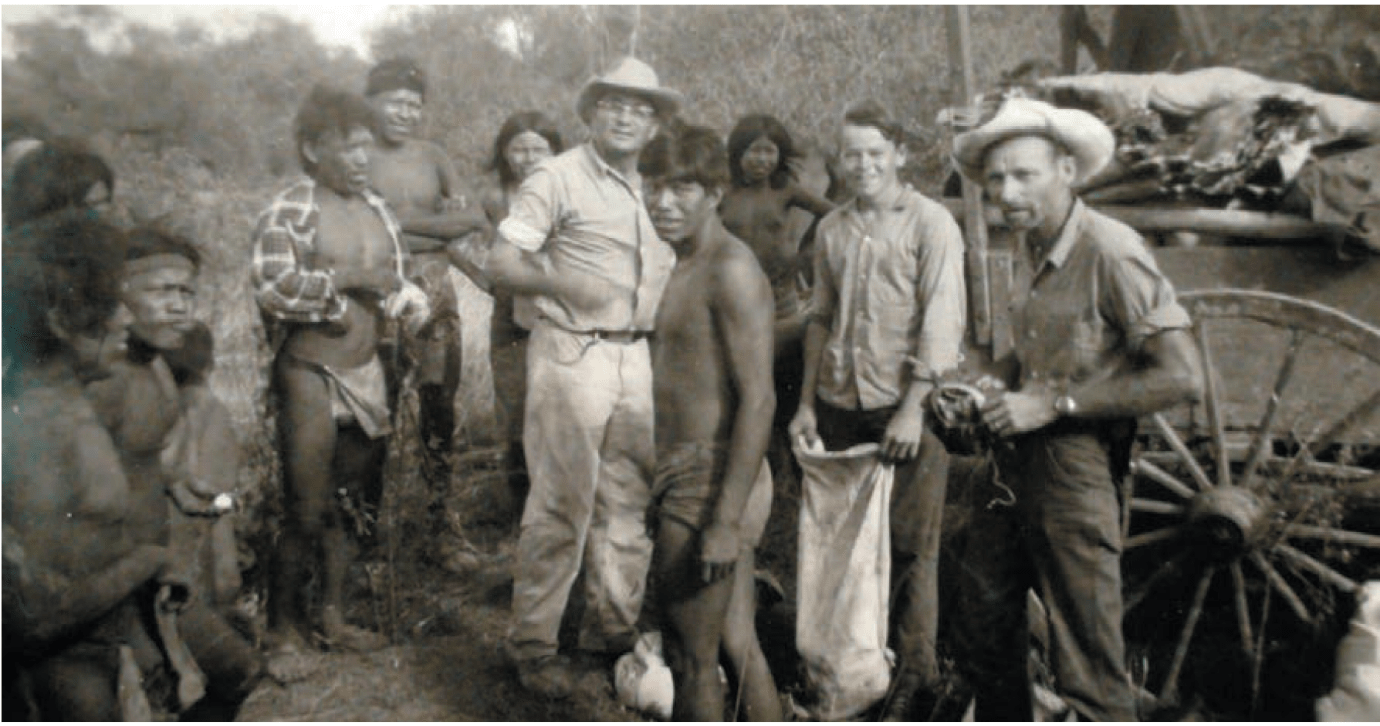
Ayoreo Ducodegosode contacted by Evangelical American missionaries in the 1960s. Credit: Archivo de la Cooperativa Fernheim en Filadelfia, Paraguay
By the early 1990s, most of the once autonomous, nomadic
Ayoreo lived a poverty-stricken existence in missionary settlements, providing
occasional day labour to Mennonites farming their territories. In his
book Behold the Black Caiman, Bessire describes the
conditions in which he found settled Ayoreo communities in the mid-2000s. He
found “thousands of […] Ayoreo-speaking people struggling to survive in the
stark mission stations and makeshift labour camps that lined dirt roads for
miles north of the Mennonite colonies”.
He wrote: “On both sides of the Bolivia/Paraguay border,
Ayoreo-speaking people were the poorest and most marginalized of any Indigenous
people in a region where camps of dispossessed Natives lined the roads and
Indians were still held in conditions described as slavery. They confronted a
mosaic of violence: enslavement, massacres, murder, and rape were venerable
traditions”.
With the fall of its dictatorship and advent of democracy in
the early 1990s, Paraguay enacted a constitution that recognised the existence
of indigenous peoples and the fact that their laws and societies pre-dated
those of the modern state. In what was regarded as one of the most progressive
ever legal instruments globally with regard to indigenous peoples, the 1992
constitution recognised indigenous peoples’ right to their identity, customary
laws, political, social and economic norms and – critically – their land
rights. It stated that indigenous peoples were entitled to shared ownership of
land “which will be sufficient both in terms of size and quality for them to
preserve and to develop their own lifestyles”. The law was a marked break with
the treatment of indigenous peoples during the dictatorship, when even their
languages were banned from education.
For the Ayoreo who had been moved from the Chaco, and who
now lived lives of poverty and discrimination outside their forests, the
constitution provided hope they could return, fully adopting the culture and
livelihoods they had not abandoned, even generations later. But it was
potentially far more significant for as many as 300 Ayoreo who remained in
isolation from the outside world. Split into several groups moving throughout
the Chaco, these Ayoreo had evaded the missionaries and the early advances of
cattle ranchers, and remained the only uncontacted tribe in South America
outside the Amazon. Others still were in a state of “initial” contact.
The isolated Ayoreo came into occasional, accidental contact
with outsiders that invariably prompted them to flee. On occasion they returned
to attack the invaders with spears and arrows, driven by a “historical
consciousness” of past violence associated with missionaries and the military
(Bessire 2014). Without the Ayoreo customary land being secured on their
behalf, under state law, it seemed inevitable that the groups in voluntary
isolation would be forced into contact, with likely devastating effects. But
they faced a huge obstacle to wresting back the land. Though the state had
recognised that it belonged to the Ayoreo, it did not hold the rights to it:
almost all of the land had been privatised.
Ill-gotten
lands
While under the dictatorship of the military officer Alfredo
Stroessner, from 1954 to 1989, most of the northern Chaco had been carved up
into 4,000 hectare (ha) lots. The government ostensibly intended to distribute
the parcels to landless and near-landless families from elsewhere in the country.
Instead, they became a personal resource for Stroessner to hand out as rewards
for his supporters and cronies. The scale of this theft would only become clear
in the mid-2000s, after a Truth and Justice Commission was established to
investigate the crimes of Stroessner’s regime, which included torture, summary
executions and forced disappearances. The Commission found that almost eight
million hectares of land had been irregularly awarded during the regime and the
15-year transition to democracy, mostly to family members, the military and
political allies of the dictator (USIP).
For some Ayoreo, the actions of missionaries and the state
were perceived as one unified effort to deprive them of their land. “It was as
if the missionaries used their evangelization to clear the territory that
belonged to the Ayoreo people,” Mateo Sobode Chiquenoi, the President of the
Unión Nativa Ayoreo del Paraguay, wrote in 2010. “That made it easy
for the cattle ranchers to buy up almost all of our land, and a few powerful
white men took over our territory just like that” (UNAP and IA 2010). The
efforts of the Ayoreo and their supporters to secure their land rights faced
the recent legacy of this mass-theft. In spite of the constitution, their
customary territory was a patchwork of tierras malhabidas: the “ill-gotten lands”
corruptly granted to hundreds of individuals.
The primary legal instrument for the implementation of
Ayoreo rights was the Indigenous Communities Statute, which established
National Institute for Indigenous Affairs (INDI) and the administrative
processes through which it should demarcate and title indigenous lands. Other
statutes incorporated a range of processes pertaining to the respect for
indigenous rights and processes required to protect them. These included Act
No. 43/89, which prohibited a change in land use in territories claimed by
indigenous peoples while the right to the land was being adjudicated (UN
Special Rapporteur 2015).
In spite of the progressive nature of the law, the
bureaucratic process of registering land was slow. It required negotiation with
the owners of ill-defined, questionably-allocated lots, with a multitude of
overlapping claims. Conflicting claims between businesses and indigenous
peoples, across the country, were frequently settled on the side of the former,
facilitated by provincial bodies “sometimes…linked to the interests of the
group occupying the land”, according to a UN report (ibid). The process was
stymied by rising land prices, with the result that the issuance of titles to
indigenous peoples was frequently limited to non-contiguous parcels that were
too small to secure the cultural viability of the communities in accordance
with the law.
The
Ayoreo Totobiegosode
Central to the land claims of the Ayoreo was a 550,000ha
expanse of forest in the southeast of the Chaco, which they and their
supporters had sought to reclaim from landowners since 1993. The land was
claimed as customary territory by and on behalf of a subgroup known as the
Ayoreo Totobiegosode, divided between some in a phase of “initial” contact and
others still in isolation. The Totobiegosode had obtained title to some land
within the block, and in 2001 had succeeded in securing “precautionary
measures”, in effect a legal injunction that prohibited other landowners from
working within the territory or selling to any other parties aside than the
government, which could then redistribute it to the Ayoreo (Survival
International 2003). The entire 550,000ha was registered by the Minister of
Education and Culture as the Patrimonio Natural y Cultural Ayoreo
Totobiegosode (PNCAT), a Natural Heritage and Cultural area, an
interim measure as they struggled to obtain full legal title. Most of the area
remained, however, a patchwork of privately-owned estates.
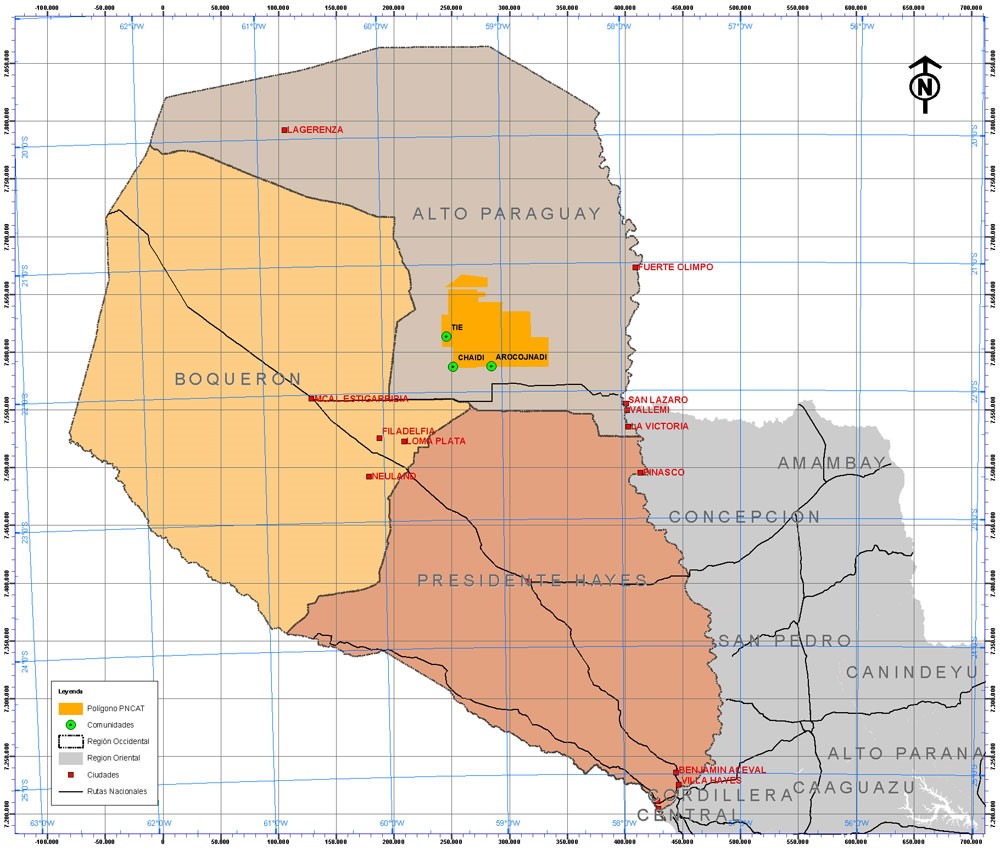
Location of the Patrimonio Natural y Cultural (Tangible e Intangible) Ayoreo Totobiegosode (PNCAT) within the Chaco.
In September 2002 a representative of the Ministerio
Público, or Public Prosecutor, carried out an investigation in the PNCAT
and found illegal logging for the protected species Palo Santo within two of
the estates. In a fly-over the following month, the prosecutor observed
“relentless” incursions by bulldozers into forests within the same two plots.
In his report he observed that the incursions were in violation of the
injunction against activities in the PNCAT and were taking place without a
legally required Environmental Impact Assessment (ABC Color 2002). The new
activities were connected to the sale of the lots by their original owners to
two Brazilian firms. These companies were at the vanguard of a proliferation of
cattle ranching in the Paraguayan Chaco that, by 2004, was pushing in from all
sides. “On satellite imagery, clear-cut checkerboards exploded around the three
Mennonite agro-religious colonies in the centre of Paraguay and the soy
plantations in southern Bolivia, even as Brazilian agri-capitalists pushed
inward from the eastern borders”, Bessire wrote.
In March 2004, the deforestation of the PNCAT provoked a group
of isolated Ayoreo Totobiegosode to make contact with settled relatives. The
appearance of the “uncontacted” tribespeople emerging from the wilderness drew
global media attention and prompted a public plea by the Ayoreo to the
government to stop the bulldozers. At a press conference in response, an
environmental prosecutor said that the illegal surveys had been authorized
since 2000 by civilian judges in Concepcion, a town several hundred kilometers
from the Chaco. He said the judges had done so despite being aware of the injunction.
He accused the judges and businessmen of feigning ignorance of the presence of
indigenous people, and Brazilian ranchers of making a mockery of the state (ABC
Color 2004).
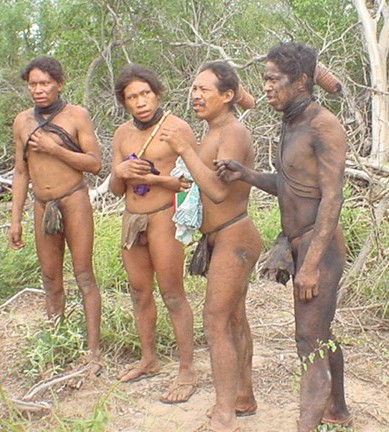
Ayoreo soon after contact in 2004 Credit: Survival International/GAT
Lucas Bessire visited the Ayoreo in the months after their
emergence from isolation. “They [had] inhabited the literal margins of
industrial agriculture,” he later wrote. “They were often forced to camp in the
fifteen-meter wide strips of brush left as windbreaks around vast cattle
pastures. They went long period communicating only with whistled sounds; even
the children were whisper quite. If they saw a boot print or heard a chainsaw,
they would flee far and fast, leaving everything behind.”
By this stage, the INDI succeeded in registering 62,000ha of
land for the Ayoreo. But the Inter American Court of Human Rights sounded a
warning that the state was not going far enough, and quickly enough, to
implement its own law and obligations under international law. In a series of
cases brought by other indigenous groups against Paraguay in 2005, the Court
ruled that the state had a legal duty to “adopt the necessary legislative,
administrative and other measures to establish an efficient mechanism that will
enable indigenous peoples to reclaim their ancestral lands and thus exercise
their property rights” (UN Special Rapporteur 2015). In the same year the
judgement was passed, the United Nations Educational, Scientific and Cultural
Organisation (UNESCO) recognized the PNCAT as part of the El Chaco Biosphere
Reserve. But the illegal actions of the landowners and indications of state
complicity were a harbinger of what was to come.
New
frontiers
A series of interconnected factors that came to a head at
this time lie at the root of the explosion of deforestation in the Chaco, and
of the current aggressive violation of Ayoreo rights. An outbreak of foot and
mouth disease in 2002 had closed many major markets to Paraguayan beef exports,
but by 2005 many had begun to open again. In 2003 Paraguay exported 36,000
tonnes of beef; by 2006 this had increased almost five-fold, to 170,000 tonnes.
The expansion of ranching on which this production was based – and promoted –
coincided with a constriction of available land in the east of Paraguay driven
by the Zero Deforestation law. This pushed cattle ranchers to look to the west,
to the “wilderness” of the Chaco for new land. It also generated a spike in
land prices in the east, encouraging many ranchers to sell up their land there
and buy at lower cost in the Chaco. Unlike the east, the inhospitable climate
and soils of the Chaco were unsuitable for large-scale soy monocultures, so the
ranchers did not have to compete with wealthy plantation businesses for land in
the new frontier.
Analysis of satellite data indicates a commensurate spike in
deforestation in 2005. But it was in 2007 that the destruction of the Chaco
began to reach the levels that would make it the world’s leading deforestation
hotspot. In 2006, an estimated 107,000ha of forest was destroyed in the
Paraguayan Chaco. A year later, it leapt to 320,000ha in a single year: an area
more than 50 times the size of Manhattan.
This new, aggressive phase of expansion is documented in
several reports of illegal incursions into land claimed by the Ayoreo. In March
2007 a company named Umbu SA began clearing “untouched virgin forest” in a
24,000ha plot thought to be inhabited by two uncontacted groups. The
deforestation threatened to disrupt a river basin that held particular cultural
significant for the Ayoreo (WRM 2007). By October the company had destroyed
8,000ha of forest for cattle ranching (UN Special Rapporteur 2009).
The next month the Ministry of Environment (SEAM) granted an
environmental license to a Brazilian ranching company named Yaguarete Pora SA,
that allowed it to clear 1,500ha of forest per year within the PNCAT – the land
at the center of territorial claims by the Totobiegosode. By the end of the
year an estimated 1,725ha of untouched forest was destroyed (ibid). At the time
the permit was issued, SEAM was part of a forum with more than a dozen private
and public organisations, convened by the UN Development Programme, focused on
the establishment of the PNCAT. But, according to Gente Ambiente y
Territorio (GAT), an NGO that works to secure Totobiegosode rights and
was involved in the forum, neither they nor any other indigenous organisations
were informed of the permit (GAT 2012).
Not only had SEAM failed to publicise the issuance of the
license; there was also a strong case that the license was illegal. As the land
was the subject of adjudication over the rights of the Totobiegosode, it fell
afoul of the law prohibiting a change of use. It also violated the
precautionary measures covering the PNCAT. The constitution itself dictated
that indigenous people could not be displaced without consent, yet Yaguarete’s
plans threatened to forcibly displace uncontacted groups whose consent could
not be sought (UN Special Rapporteur 2015).
The license was the subject of an audit by the Contraloría
General, which raised doubts over the veracity of the environmental impact
assessment that underpinned it. It found Yaguarete had ignored data presenting
evidence of the presence of uncontacted communities dating back to the 1990s.
The Contraloría General noted “omissions, inaccuracies and
inconsistencies” in the request for approval for the ranch, and that these
irregularities contradicted provisions of the Law on Environmental Impact
Assessment and Environmental Crimes (ABC Color 2008a). The license was also
review on two occasions by the National Environment Council (CONAM), which
ruled that it should be cancelled.
But at the same time, Yaguarete and another company, River
Plate SA, began clearing forest in the PNCAT, devastating the fragile
biodiversity in the south of the territory. The surge was reportedly in clear
violation of provisions adopted by CONAM, while River Plate’s operations
ignored a suspension of activities ordered by the Attorney General’s
Specialized Environmental Criminal Unit (ABC Color 2008b). The new wave of
deforestation drew most attention within the PNCAT, but was far from isolated
to it. In July 2008 a ranching firm named S.A. Los Molinos began clearing in
Palmar Islands, an area on the border with Bolivia in the far north of the
Paraguayan Chaco, known to be used by uncontacted groups. Within a year it had
destroyed 3,000ha of forest (UN Special Rapporteur 2009).
SEAM eventually cancelled Yaguarete’s illegal environmental
license in November, after it had cleared more than 2,000ha within the PNCAT.
Juan Rivarola, the Ministry’s legal adviser, told a reporter that the
cancellation was a result of the irregularities in the process by which it had
been allocated, but also because of “the refusal by the owners of Yaguarete
Pora to allow the Secretariat of the Environment to monitor and oversee
compliance with the environmental management plan” (IPS News 2008).
“Non-compliance with the environmental mitigation measures
is not only grounds for canceling the permit, but is a crime,” he said. “If it
is found that a larger area than what was authorised has been deforested, the
public prosecutor’s office will have to act”.
In spite of the revocation of the permit, Yaguarete and
numerous other companies retained title to land in territories claimed by the
Ayoreo. An Ayoreo man named Chagabi Etacori told a reporter: “We know the
permit was canceled, but we don’t believe the problem will end here, because
we’re talking about people who have a great deal of economic power”.
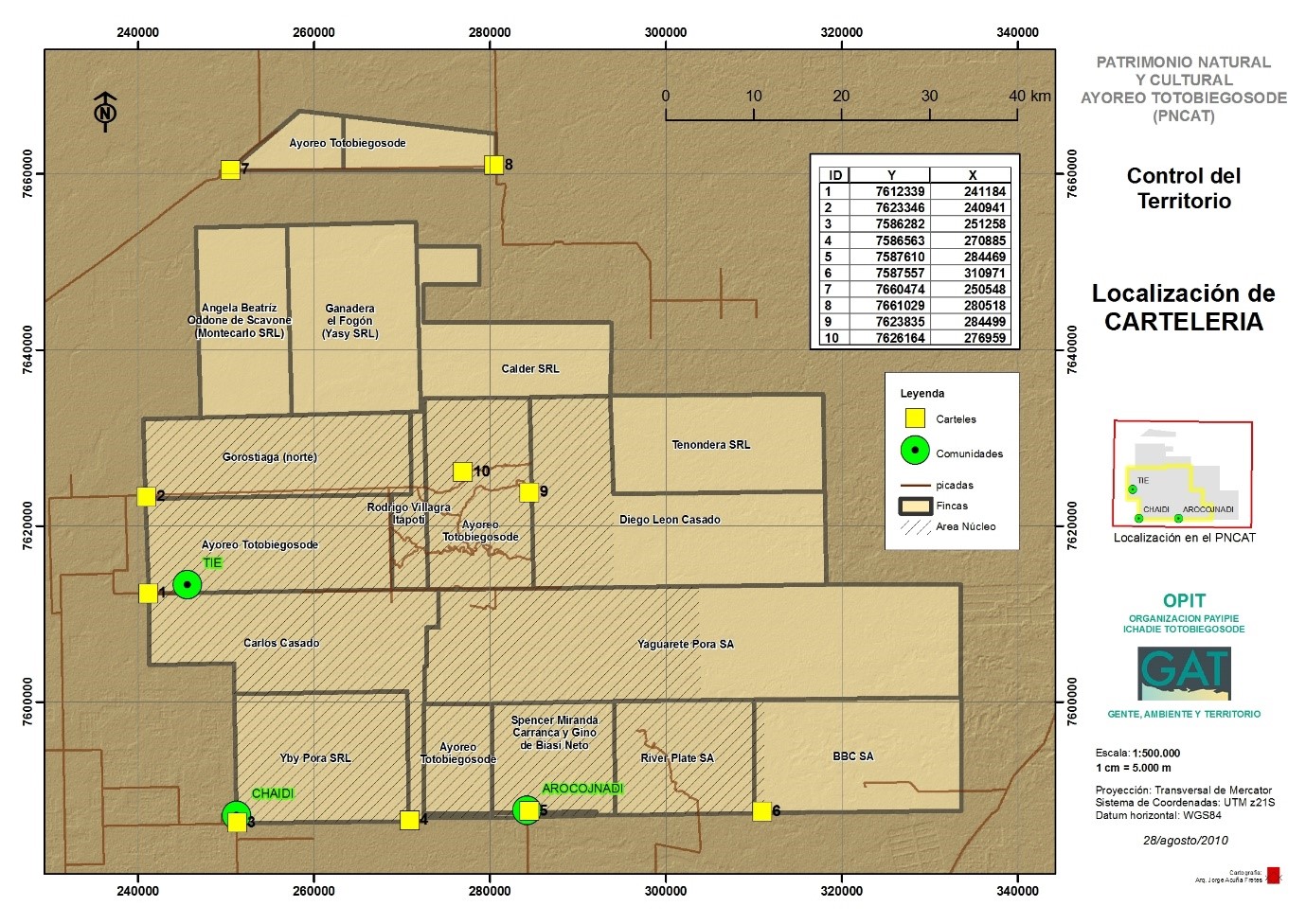
Private ranching estates within the PNCAT. Credit: GAT
A culture of impunity
The ability of companies to violate the law has undoubtedly
been enabled by the absence of state in the wilds of the Chaco. A 2013 study
highlighted the inability of state agencies to effectively monitor businesses
as “the largest problem” in implementing laws regulating deforestation. It
found that SEAM, which was responsible for ensuring companies complied with
forest management plans, had only 11 employees and two cars to cover millions
of hectares. As a consequence it focused solely on companies that were the
subject of complaints by third parties. The 11 employees still had to cope with
15 complaints each day (Verijdt 2013).
An academic paper published this year examined the role of
varying levels of environmental regulation in the Chaco, and neighbouring
biomes, in influencing the location of agricultural investments. Perhaps
inevitably, it found that lower deforestation regulations and weaker
enforcement attracted companies that tend to clear more forest. This factor was
evident in the displacement of ranching from Brazil into the Chaco, and even
from more robust jurisdictions within the Chaco (Lambin et al 2016).
The paper also noted the role of the industry in maintaining
the light regulatory regime in the Paraguayan Chaco. In 2009, as the scale and impact
of deforestation on the fragile landscape began to become apparent, a proposal
was tabled to extend the zero deforestation law to the Chaco province of Alto
Paraguay. The proposal was rejected by the Chamber of Deputies, after several
representatives were lobbied by Brazilian ranchers and plantation owners.
Yet the extent to which some companies have been able to
evade the law is not adequately explained by either weak legislation or a lack
of capacity. The 2013 study also found numerous allegations of corruption
levelled against SEAM. According to the law each estate must retain 25 per cent
forest cover. Both NGOs and investors reported that SEAM officers would accept
bribes to allow companies to deforest beyond this threshold.
The Ministry displayed wild inconsistencies in its treatment
of Yaguarete, perhaps the most high-profile case in the Chaco, that reveal
tension between the rule of law and the influence of industry. After revoking
the environmental license, SEAM opened an investigation into the allegations
Yaguarete had concealed information on the presence of uncontacted Ayoreo in
its Environmental Impact Assessment. In 2010 an Administrative Court upheld the
allegation and issued what the NGO Survival International described as an “unprecedented”
fine of US$16,000. In order to process a new environmental license for its
still extant landholding, Yaguarete was required to carry out a new, legitimate
environmental impact assessment (GAT 2014).
But in late 2013, the license was reissued without a new
assessment, and Yaguarete resumed clearing in the PNCAT. After Totobiegosode
leaders appealed to the senate to intervene, Senator Miguel López Perito urged
the state to acquire the land once and for all and return it to them. López
Perito told reports that SEAM had failed to respond to requests for information
from the senate on why the license was illegally reissued. He suggested that
Yaguarete “has its own Executive Power” (Efe Verde 2014).
Cartes:
Use and abuse Paraguay
Yaguarete’s new license coincided with the resumption of
power by the Colorado Party. The right-wing party had controlled government in
Paraguay uninterrupted, including through the dictatorship of Stroessner, for
60 years until a left-wing former priest named Fernando Lugo won the Presidency
in 2008. The Lugo government proposed agrarian reforms to undo the toxic legacy
of tierras malhabidas, and improve the plight of millions of
poverty-stricken landless people. But Lugo was impeached by congress and pushed
out of government in 2013, in what was described as a coup, after a
high-profile, violent clash between police and landless peasants attempting to
reclaim land from a former Colorado senator.
The Colorados retook power with the election to president of
Horacio Cartes, a businessman who had made millions from the drink, tobacco and
meat industries. Diplomatic cables released by Wikileaks also named Cartes as
the head of a money laundering and drug trafficking organization operating in
the Chaco. Cartes repudiated the allegations to the Paraguayan media before his
election (ICIJ 2013). The resumption of power by the Colorado Party was a death
knell for progressive land reforms, and a significant boost for businesses
seeking political influence and a pliant regulatory environment.
Under the party, rapid economic growth had been promoted
through monoculture plantations and ranching. This was facilitated by the
concentration of ownership land among the rich and the elite. A 2008 census
found that 1.6 per cent of the population controlled 80 per cent of all
agricultural land, leaving much of the remaining population landless and
impoverished. The majority that land was taken up by large-scale soy
plantations, contributing to the sky-high deforestation levels in the Atlantic
forests. Though overall economic growth was rapid, the concentration of land
and resources prevented the fruits of that growth trickling down. By 2013 had
the 11th worst income distribution in the world, with almost half living
below the poverty line (GIZ).
Cartes’ assumption of power represented a shift in the
balance of power back towards wealthy landowners and plantation firms, and away
from landless peasants. In early 2014, Cartes met with a delegation from the
National Confederation of Brazilian Business in the Government Palace, in
Asuncion. He encouraged them to invest and promised to “give comfort” to
investors. “I want you to feel at home,” he said. “Use and abuse Paraguay,
because the truth is for me, this is an incredible moment of opportunity. The
land is yours, the country is yours” (Buenos Aires Herald 2014).
Voluntary
isolation and international human rights law
As deforestation continued at a pace unrivalled anywhere
else on earth, the isolation of the Ayoreo from the outside world grew
increasingly untenable. In the northern Chaco, evidence of their presence has
consistently emerged in areas exposed by the expansion of farms. The Ayoreo’s
traditionally peripatetic livelihood and light use of resources means that only
fragile vestiges are found. But in the wilderness of the Chaco, to the trained
eye, they are unmistakable: abandoned huts, hunting lances, holes carved
in quebracho trees to extract honey, clan markings carved into bark.
Since 2004 these signs have been documented
by Iniciativa Amotocodie, an NGO that advocates for Ayoreo rights. The
evidence suggests the disparate groups of nomads remain spread across the
Chaco. But overlaying the locations of sighting with farmland demonstrates the
extreme strictures on their ability to move through untouched forests, and the
increasing likelihood of forced contacts.
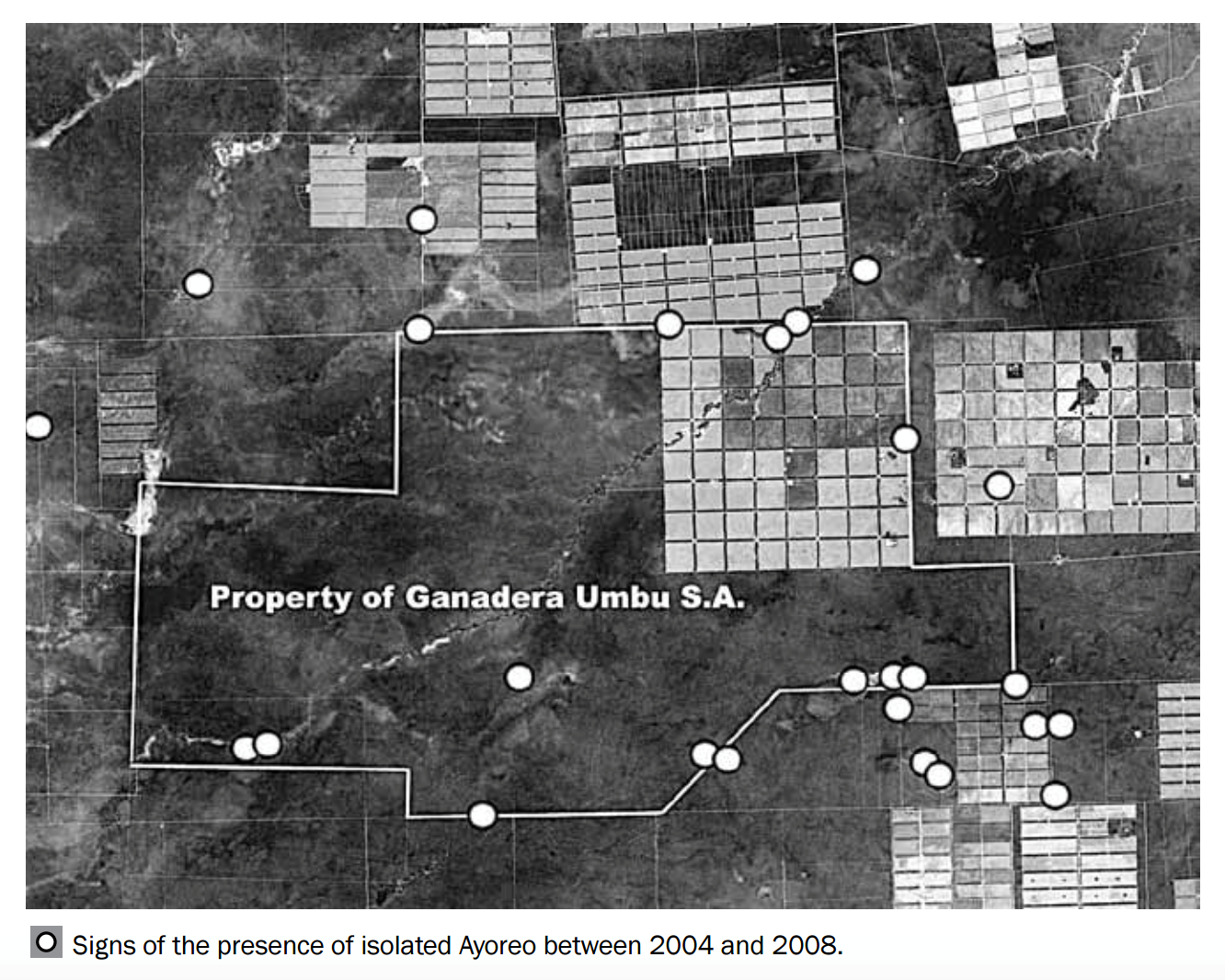
As indigenous people in voluntary isolation, the rights of
the Ayoreo are afforded extensive protection in international human rights law,
in addition to those embodied in Paraguay’s statute book. This body of law is
incorporated in a range of international and regional treaties and conventions
to which Paraguay is signatory, and thus legally obliged to implement.
Fundamental to this is the right to self-determination, which, in the case of
isolated peoples, extends to their right to continue to live in isolation.
A 2013 report by the Inter-American Commission on Human
Rights emphasised the importance of recognising that in most cases this right
has been consciously exercised. “Peoples in voluntary isolation cannot be
considered “uncontacted,” strictly speaking, since many of them, or their
ancestors, have had contact with persons from outside their peoples,” the
report stated. “Most of these contacts have been violent and have
had serious consequences for the indigenous peoples, which have led them
to reject contact and return to a situation of isolation or increase the
degree of isolation” (IACHR 2013).
This situation is patently true of the isolated Ayoreo, who
have been in contact with other Ayoreo settled by missionaries. The latter
consistently report their refusal to engage with non-Ayoreo, whom they refer to
as “cojñone”, or “people without correct thinking”. When they have been
forced into contact, as in 2004, it has not been of their own volition, but
forced through the incursions of ranchers.
For communities in voluntary isolation, it is established
that the act of withdrawing from contact with outsiders should be interpreted
as a withholding of consent for any activities in their territory. The UN
Office of the High Commissioner for Human Rights has issued specific guidelines
on the rights of isolated peoples in the Amazon and Gran Chaco, including the
recommendation that “the areas that States have delimited for peoples in
voluntary isolation or initial stages of contact must be untouchable….(where)
no rights to exploit natural resources must be granted” (OHCHR 2012).
In response to the failure of the Paraguayan government to
uphold these rights, the Ayoreo and their representative groups have repeatedly
raised their case with both the UN Special Rapporteur on the Rights of
Indigenous Peoples and the Inter-American Commission on Human Rights. Victoria
Tauli-Corpuz, the Special Rapporteur, undertook a week-long visit to Paraguay
in November 2014 to assess the situation, at the invitation of the government.
A report published the following year noted that she had observed “a widespread
lack of legal protection for indigenous peoples’ rights over their lands, territories
and resources, which are vital to ensure their survival and uphold their
dignity. This situation gives rise to numerous conflicts and subsequent human
rights violations”. The report stated that the government should regard the situation
as an “emergency”.
Tauli-Corpuz made a series of wide ranging recommendations
to the government, from immediate measures to eliminate the risk of unwanted
contact with Ayoreo in isolation, to the establishment of an entirely new
framework for indigenous peoples’ rights over their lands. Events in the Chaco,
at the time the report was released, served only to reemphasize the urgency of
the situation. Two days before it was published, in August 2015, five heavily
armed security guards allegedly hired by a landowner reportedly intimidated
Ayoreo Atetadiegosode in Boqueron department, by shooting into the air. The
Ayoreo were inspecting the land because they feared it was being deforested.
Two months later, satellite analysis by an NGO that
advocates for Totobiegosode rights reported that Yaguarete Pora SA continued
bulldozing their territory “without pause, and with impunity”. The NGO
denounced the deforestation to SEAM and the National Forestry Institute,
without receiving any response. “The Environment Secretariat is fully aware
that deforestation of indigenous territory is illegal,” they wrote, “as it was
notified by judicial offices referred by the Court of Auditors” (GAT 2015).
This year, the Inter-American Commission on Human Rights
responded to the growing crisis by passing a resolution requesting the
Paraguayan government to adopt precautionary measures, that would protect the
rights of the communities in isolation.
The Commission called for a cessation of deforestation in
Totobiegosode lands, and the establishment of a mechanism to prevent third
parties entering their territory. A summary of the resolution stated: “After
analysing the allegations of fact and law, the Commission considers that the
information presented demonstrates, prima facie, that the communities in
voluntary isolation of the Ayoreo Totobiegosode People are in a serious and
urgent situation given that their rights to life and personal integrity are
allegedly threatened and at risk” (IACHR 2016).
End
markets
In 2015, for the first time, Paraguay exported more beef
than neighbouring Argentina, a powerhouse of ranching and beef production. An
article in an industry publication on the once “unthinkable scenario” noted
that “..unlike Argentina, the Paraguayan government supports a very free market
approach to agriculture which is conducive to exporting beef” (ADHB Beef &
Lamb 2015).
The vast majority of these exports leave for Russia, Chile
and Brazil, markets less sensitive than the EU, which banned Paraguayan beef
due to an outbreak of disease in 2011. Survival International has, in the past,
requested that the EU ban imports on the basis that beef production is driving
the illegal violation of Ayoreo rights, without success. Last year the ban
imposed on health grounds was lifted, opening the vast EU market to Paraguayan
beef once again.
The exponential growth of production and exports has done
little if anything to relieve poverty among the landless and among indigenous
peoples, in particular. Although overall poverty has declined in recent years,
according to the Paraguayan government’s estimates 60 per cent of indigenous
peoples live in “extreme poverty” (Oxfam 2013). More than half of all
indigenous children under the age of five suffer from chronic malnutrition. The
expansion of agriculture for export has, paradoxically, had a demonstrable
negative impact on food security. Oxfam has noted that after access to land is
deprived, “[they] lack viable economic alternatives and face exclusion from the
economy and access to healthcare in settlements”, findings echoed by the UN
Special Rapporteur.
While the expansion of soy into the Chaco has been limited
to date, many producers are evaluating its viability for plantations, and
trials are reportedly underway for heat-tolerant soybeans that might thrive in
the otherwise hostile soils. Local analysts believe the Chaco could provide
some two million hectares of land for expansionist soy firms (USDA 2016), a
development that would likely sound a death knell for the way of life of the
isolated Ayoreo.
In the Chaco, the Ayoreo and their supporters continue their
struggle with the multitude of companies that already lay claim to the land and
their invisible, but seemingly sprawling, hold on the state. “I remember my
father saying that we used to have to fight to defend our territory,” Carlos
Etacore, an Ayoreo leader, told a journalist in January this year. “Now we have
to fight with the ways of the white man, with documentation and denunciations
and paper. And sometimes, it works” (Guardian 2016).
References:
ABC Color. 2002. “Con topadoras destruyen selva de Ayoreos en el Alto Paraguay”
ABC Color. 2004. “Silvícolas, desesperados, piden a blancos que paren sus
topadoras”
ABC Color. 2008a. “Hallan causales para cancelar licencia a firma agropecuaria”
ABC Color. 2008b. “Brasileños desmontan territorio Ayoreo”
ADHB Beef & Lamb. 2015. “Paraguayan beef exports increase”
Bessire, Lucas. 2014. “Behold the Black Caiman: A Chronicle of Ayoreo Life”
Buenos Aires Herald. 2014. “Cartes: Brazil’s firms can ‘abuse’ Paraguay”
Efe Verde. 2014. “Indígenas
paraguayos piden la intervención del Senado para frenar la tala ilegal”
GAT. 2012. “Una experiencia
de suma de esfuerzos”
GAT. 2014. “Nueva deforestación
realiza Yaguarete Pora SA en zona de aislados”
GAT. 2015. “Sin
pausas, y con impunidad, Yaguareté Pora SA prosigue deforestación en bosques
indígenas”
Guardian. 2016. “Disappearing
world: Paraguay’s Ayoreo people fight devastating land sales”
GIZ. Undated. Paraguay profile.
Hansen, M.C., P.V. Potapov, R. Moore, M. Hancher, S.A.
Turubanova, A. Tyukavina, D. Thau, S.V. Stehman, S.J. Goetz, T.R. Loveland, A.
Kommareddy, A. Egorov, L. Chini, C.O. Justice, and J.R.G. Townshend. 2013.
“High-Resolution Global Maps of 21st-Century Forest Cover Change.” Science 342
(6160): 850-853. doi: 10.1126/science.1244693.
IACHR. 2013. “Indigenous
people in isolation and initial contact in the Americas”
IACHR. 2016. Resolution PM 54/13 “Matter of
communities in voluntary isolation of the Ayoreo Totobiegosode People, Paraguay”
ICIJ. 2013. “Bank
Owned by Paraguay’s Leading Presidential Candidate Linked to Tax Haven”
IPS News. 2008. “Paraguay: Uncontacted
Ayoreo Threatened by Deforestation”
Lambin et al. 2016. “Land-use policies
and corporate investments in agriculture in the Gran Chaco and Chiquitano”
OHCHR. 2012. “Directrices de protección para los pueblos
indígenas en aislamiento y en Contacto Inicial de La región Amazónica, el Gran
Chaco y la región oriental de Paraguay”
Oxfam. 2013. “The
soy mirage”
Survival International. 2003. “Bulldozers enter the heart
of isolated Indians’ land”
Unión de Nativos Ayoreo de Paraguay and Iniciativa
Amotocodie. 2010. “The
Case of the Ayoreo”
UN Special Rapporteur on the rights of indigenous peoples.
2009. “Report by the Special Rapporteur on the situation of human rights and
fundamental freedoms of indigenous people.. Addendum. Summary of
communications transmitted and replies received”
UN Special Rapporteur on the rights of indigenous peoples.
2015. “Report:
The situation of indigenous peoples in Paraguay”
United States Institute of Peace. Undated. “Truth
Commission: Paraguay”
US Department of the Interior. 1959. “Geology and Mineral Resources of
Paraguay – A Reconnaissance”
USDA. 2016. Paraguay: Oilseeds and Products Annual.
Verijdt, Gemma. 2013. “The
rush for the last SouthAmerican land reserve: the Paraguayan Chaco”
World Rainforest Movement. 2007. Issue 123.
WWF 2006. “WWF Lauds Paraguay for Slashing Deforestation 85 Percent“
